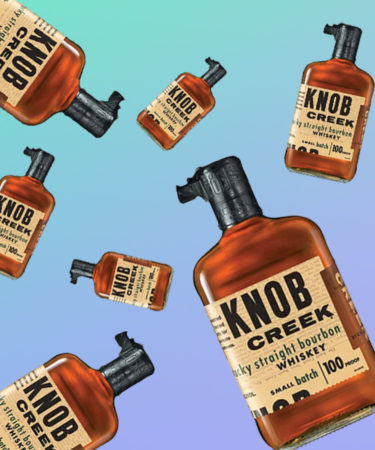When Knob Creek launched in 1992, it was an anomaly. At the time, small-batch bourbon with a steep price tag was not a common sight. Since then, America has experienced a bourbon boom, with whiskey lovers willing to shell out serious cash for premium booze.
Born in Kentucky and praised across the nation, Knob Creek continues to reign as a preferred small-batch whiskey (we’re partial to the single barrel). From its secret past, to notable craft brewery collabs, here are eight things you should know about Knob Creek.
Whiskey Runs In The Family.
Knob Creek is distilled under the direction of master distiller Fred Noe. Fred is the son of Knob Creek founder, Booker Noe, who is the grandson of Jim Beam.
Knob Creek has siblings.
Operating under parent company Beam Suntory, Knob Creek’s three “siblings” are also brewed at the Jim Beam distillery: Booker’s, Baker’s, and Basil Hayden’s. All four are billed as small-batch bourbons for the high-end market.
It’s bourbon, yes, but it’s not just bourbon.
Knob Creek comes in four varieties: Kentucky Straight Bourbon Whiskey, Straight Rye Whiskey, Smoked Maple Bourbon Whiskey, and Single Barrel Reserve. The first is a bold, sweet, pre-Prohibition-style bourbon. The rye is ideal for cocktails like a classic Old Fashioned, Manhattan, or Sazerac. Smoked Maple Bourbon is a lower-proof option fortified by charred oak, while Single Barrel Reserve is a big, unblended bourbon at a whopping 120 proof.
Knob Creek’s 25th birthday party was better than yours.
In 2017, Knob Creek celebrated its 25th anniversary, and did it big. Like, 300 versions of 120+ proof bourbon big.
Knob Creek 25th Anniversary Bourbon was the brand’s first unfiltered, cask-strength, single-barrel offering. It rang in at 120 proof (60 percent ABV), sold for $130 a bottle, and, because 300 barrels were included in the release, technically, 300 different versions of the bourbon were sold.
… But the brand is actually much older than you.
Knob Creek of today may be 26 years old, but the brand name was in use long before the Noes revived it in 1992. According to Kathleen DiBenedetto, director, global brand education at Beam Suntory, the Knob Creek label was first in use in 1898. It was owned at the time by the Penn-Maryland Corp., a division of National Distillers. Jim Beam purchased National Distillers In 1987, and Knob Creek was resurrected.
Ageless beauty doesn’t come cheap.
In September 2016, Knob Creek announced it would be ditching its nine-year age statement in effect since 1992. Previously, the brand strictly adhered to a blend of whiskies of at least nine years old. With the change, the flagship blend would include whiskies younger than nine years old, as well as older. According to Knob Creek, the availability of aged whiskey at the distillery would allow the blend to achieve the same flavor profile.
But, that’s up for debate. In 2009, Knob Creek production was halted due to a shortage. Beam embraced it, running print ads that read, “Thanks for nothing,” handing out T-shirts referring to the “drought of 2009,” and sending journalists empty Knob Creek bottles. At the time, Fred Noe said in an interview that the company chose not to solve the shortage by using younger whiskies because it would be “compromising the product.”
It’s as American as Abraham Lincoln.
Knob Creek is the name of an actual creek in Kentucky. Allegedly, the creek ran through Abraham Lincoln’s family farm, which Lincoln referred to as “the Knob Creek place.” Some sources say Abe’s father worked as a seasonal hand at a nearby distillery. None of this is definitively true, but all of it is pretty darn charming.
Knob Creek collaborates with craft breweries.
As legend has it, in the early 1990s, Booker Noe, then-master distiller of Knob Creek, and Greg Hall, Goose Island founder and then-brewmaster, met at a dinner in Chicago. They got to chatting, and Hall mentioned that he wanted to do something special for Goose Island’s thousandth brew. It was in this conversation that the famous Goose Island Bourbon County Brand Stout was conceived.
The history from there is a bit blurry. Goose Island originally stated on its Bourbon County labels that the brand originated in 1992. Later, it was estimated that the legacy began in 1995, when the beer was first entered into the Great American Beer Festival. Whatever the case, the barrel-aged stout is legendary and recognized as at least partially responsible for all the barrel-aged beers we have today.
In honor of Knob Creek’s 25th anniversary in 2017, Goose Island debuted its first Goose Island Reserve Bourbon County Brand Stout, aged exclusively in 11-year-old, freshly dumped Knob Creek barrels. (The regular BCS is aged in a variety of second-use, fresh-unrinsed, five-to-seven-year-old barrels.)
Knob Creek also told VinePair it will be launching a collaboration with New Belgium Brewing in September 2018. Oakspire Bourbon Barrel Ale is a limited-edition, bourbon-inspired rye ale made with Knob Creek bourbon-soaked oak spirals and barrel char. It weighs in at 9 percent ABV.
